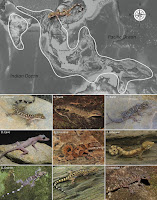Abstract
Understanding the processes that underpin adaptive evolutionary shifts within major taxonomic groups has long been a research directive among many evolutionary biologists. Such phenomena are best studied in large monophyletic groups that occupy a broad range of habitats where repeated exposure to novel ecological opportunities has happened independently over time in different lineages. The gekkonid genus Cyrtodactylus is just such a lineage with approximately 300 species that range from South Asia to Melanesia and occupy a vast array of habitats. Ancestral state reconstructions using a stochastic character mapping analysis of nine different habitat preferences were employed across a phylogeny composed of 76% of the known species of Cyrtodactylus. This was done in order to ascertain which habitat preference is the ancestral condition and from that condition, the transition frequency to more derived habitat preferences. The results indicate that a general habitat preference is the ancestral condition for Cyrtodactylus and the frequency of transitioning from a general habitat preference to anything more specialized occurs approximately four times more often than the reverse. Species showing extreme morphological and/or ecological specializations generally do not give rise to species bearing other habitat preferences. The evolution of different habitat preferences is generally restricted to clades that tend to occur in specific geographic regions. The largest radiations in the genus occur in rocky habitats (granite and karst), indicating that the transition from a general habitat preference to a granite or karst‐dwelling life style may be ecologically uncomplicated. Two large, unrelated clades of karst‐associated species are centered in northern Indochina and the largest clade of granite‐associated species occurs on the Thai‐Malay Peninsula. Smaller, independent radiations of clades bearing other habitat preferences occur throughout the tree and across the broad distribution of the genus. With the exception of a general habitat preference, the data show that karst‐associated species far out‐number all others (29.6% vs. 0.4%–10.2%, respectively) and the common reference to karstic regions as “imperiled arcs of biodiversity” is not only misleading but potentially dangerous. Karstic regions are not simply refugia harboring the remnants of local biodiversity but are foci of speciation that continue to generate the most speciose, independent, radiations across the genus. Unfortunately, karstic landscapes are some of the most imperiled and least protected habitats on the planet and these data continue to underscore the urgent need for their conservation.
Keywords: ancestral state reconstruction, Asia, ecology, Gekkonidae, limestone, phylogeny, stochastic character mapping
L. Lee Grismer, Perry L. Wood Jr., Minh Duc Le, Evan S. H. Quah and Jesse L. Grismer. 2020. Evolution of Habitat Preference in 243 Species of Bent‐toed Geckos (Genus Cyrtodactylus Gray, 1827) with A Discussion of Karst Habitat Conservation. Ecology and Evolution. DOI: 10.1002/ece3.6961






